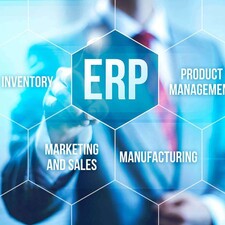Blog
The Right ERP KPIs To Better Manage Inventory and Quality Control

Summary
An Interview with ERP KPIs Expert Paul Hemmings, Part 2
In part one of this series, we looked at ERP KPIs and how The KPI Playbook for Modern Manufacturers can be used to drive efficiency in manufacturing/production. In this second post, we’ll look at how the Playbook can help your manufacturing company better manage its inventory and quality control. Again, we asked KPI expert and abas Special Projects Manager, Paul Hemmings, to offer insights here.
Inventory ERP KPIs
You’ll want to run as lean as possible, eliminating additional costs around carrying unused materials or having too much work in process or customer returns. Like so many of these KPIs, inventory management and quality control are deeply intertwined. As Paul Hemmings repeatedly emphasizes, having insufficient quality controls from the time you receive materials from your suppliers all the way down the line until your customer receives the goods will directly impact your inventory costs and your overall efficiency.
Percentage of Finished Goods Versus COGS
“This KPI is making sure you’re not ignoring any hidden costs,” explains Hemmings. “For instance, inventory turns. That is a famous KPI that a lot of people use. It provides valuable information on how well your purchasing, sales, and planning functions are operating. You’ve got to ensure you don’t look at it as just a number. You’ve got to say, if the number is off, is it because I’m over-promising my sales? Are my forecasts wrong? Is my purchasing department buying too much? That’s definitely not 'just in time' inventory. I call it ‘just in case inventory."

Too Much Inventory = Cost Inefficiencies
"Just in Case" inventory is cost inefficient. “It doesn’t matter whether it’s raw material, work in process or finished goods,” says Hemmings. “What all these do is tie up your cash that could be used elsewhere in your business. I’ll sometimes go through customers’ facilities and rub my finger on some inventory and there’ll be half an inch of dust on it. That’s 'just in case inventory' eating up capital. It creates hidden costs such as additional material handling costs, damage to material stored, material redundancy, and material expiration.”
Just in case inventory creates hidden costs often counted as expenses, additional material handling costs, damage to material stored, material redundancy, and material expiration
Having an accurate cost of goods sold (COGS) is essential to help you determine your profitability, and you need to dive deeper into those numbers to analyze hidden costs related to inventory. “This is where your ERP system will help,” notes Hemmings, “because it highlights inefficiencies and waste which reduce profitability and tie up money. The cost of goods sold is a lot broader in my opinion than just a line on a financial report.”
Rate of Work in Process
Having too much work in process is inefficient and can be a sign of deeper problems. “The reasons we see high amounts of work in process is you’re producing goods in advance because you have a forecast, or maybe you have to supply them on short notice or you have seasonal demand,” explains Hemmings. “If those forecasts are inaccurate and not updated based on market conditions, you’re making too much work in process that’s tying up your equipment, personnel and cash.”
Instead, a manufacturer needs to make the best use of equipment and personnel. “The longer something is kept in inventory, the higher the chance it’s going to get lost, misplaced, damaged, stolen, or expire,” says Hemmings. “You might see a company promoting their brand new warehouse, but did they do all the analysis they needed to decide whether that investment was necessary? Or maybe they didn’t manage their inventory correctly?”
High Rate of Customer Returns
This KPI has a clear impact on the financial bottom line but also can point to operational and quality control problems within a manufacturer. “One of the major causes of high return rates is poor quality control procedures from the point where materials from suppliers are received all the way through the production and distribution process. It can also be related to poor sales and shipping management, e.g., wrong products ordered or goods damaged in transit. You’ve got to be able to monitor quality all the way through to the point that your products get to the customer.”
One of the major causes of high return rates is poor quality control procedures
And with this KPI, as with all of them, your ERP system is an invaluable tool in rooting out and resolving problems. “Use your ERP software to analyze the data. Ask customers why they’re returning items. Identify trends. Use your analysis capabilities with ERP software so you can isolate and identify the causes of the problems, then respond to remedy the problems,” says Hemmings.
Democratize ERP KPIs to Drive Employee Performance
Paul Hemmings is passionate about democratizing ERP KPI’s. He doesn’t see them only as the concern of the top leadership team, but advocates their use across the entire organization, from top to bottom. “KPI’s tend to be focused at the high level. What companies need to do more is get their employees involved with their own assigned KPIs. Give them some responsibility. Give them some measurements. Visualizing the KPIs through accessible dashboards is extremely valuable for everyone inside a manufacturer.”
KPIs, if made more transparent and used as tools to drive performance throughout the organization, can trigger employee engagement around the company’s strategic indicators. “We are working with a number of companies that are putting flat screen displays in the warehouses or production floors,” says Hemmings. “That way, people get a sense of how well everybody’s meeting their goals. It’s not there to beat people up. It’s there to say, look, we’re doing well today or we’re a bit behind, what do we need to do to catch up?”
Hemmings offers a bit of final advice for manufacturers in democratizing their ERP KPIs: “Get everybody involved. Use the tools you have to communicate to everybody in the company how the company is doing. If your sales are going up, your production is on time, your scrap rates are down, then tell people ‘Great job!’ Use the data that’s there to help your people improve your business and your organization.”

For more information on defining, monitoring, and leveraging ERP KPIs, download The KPI Playbook for Modern Manufacturers


